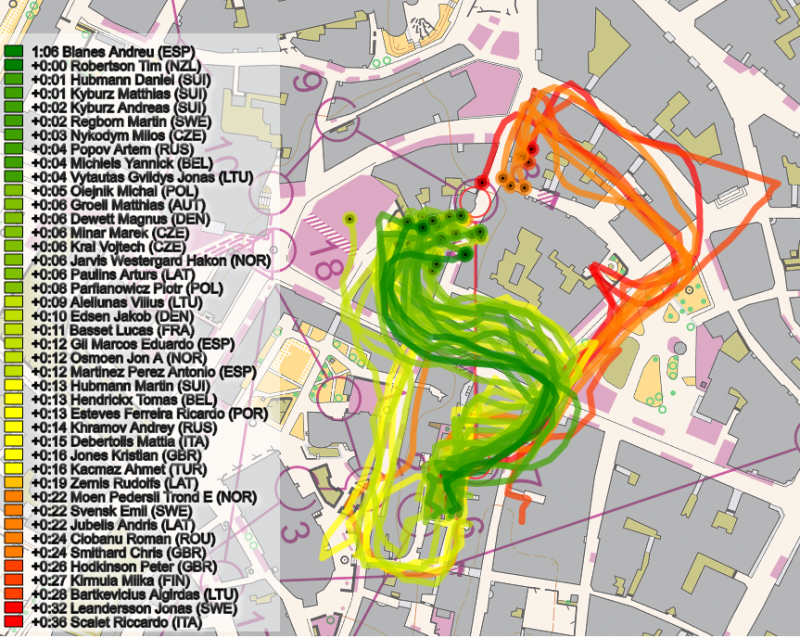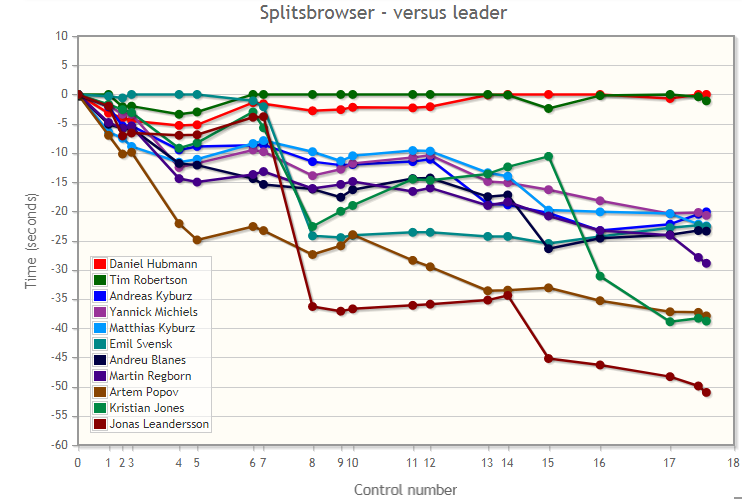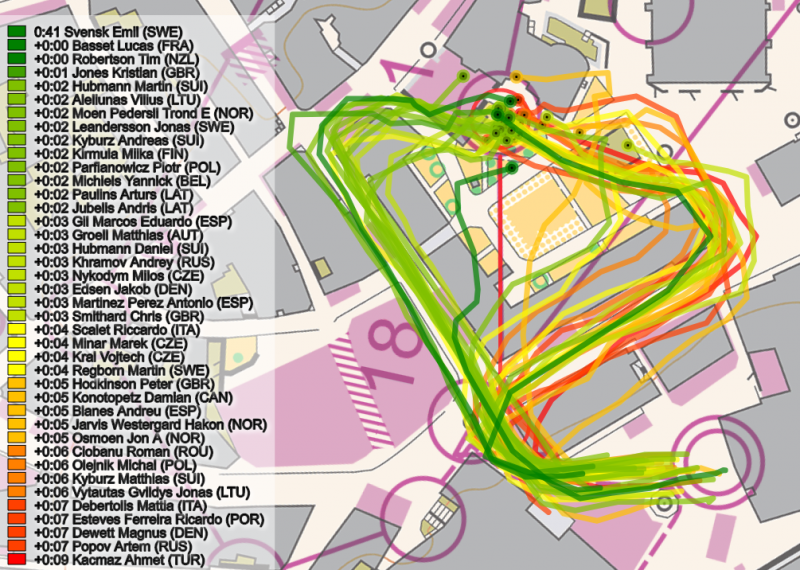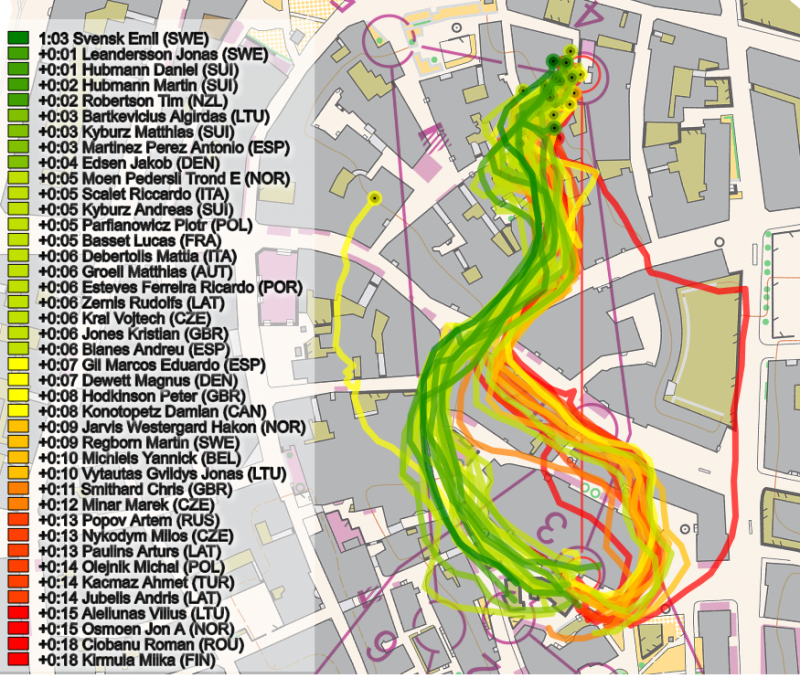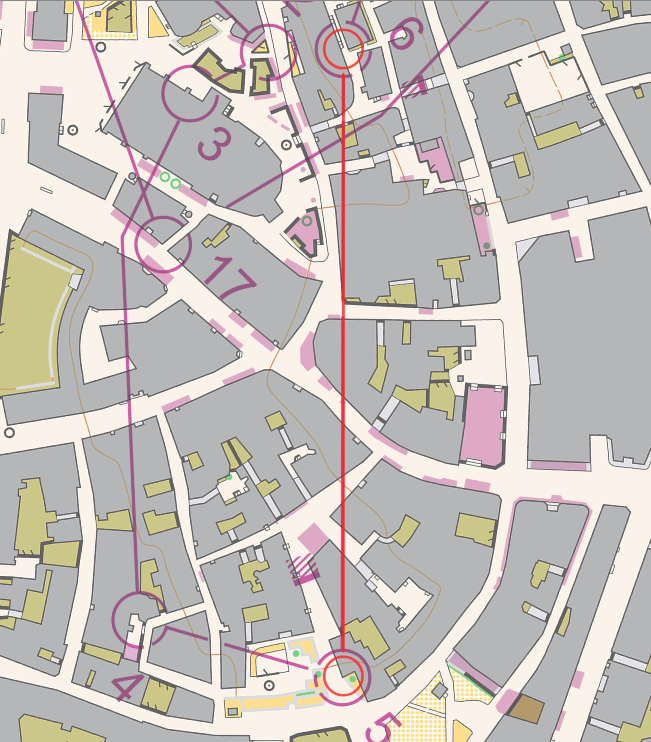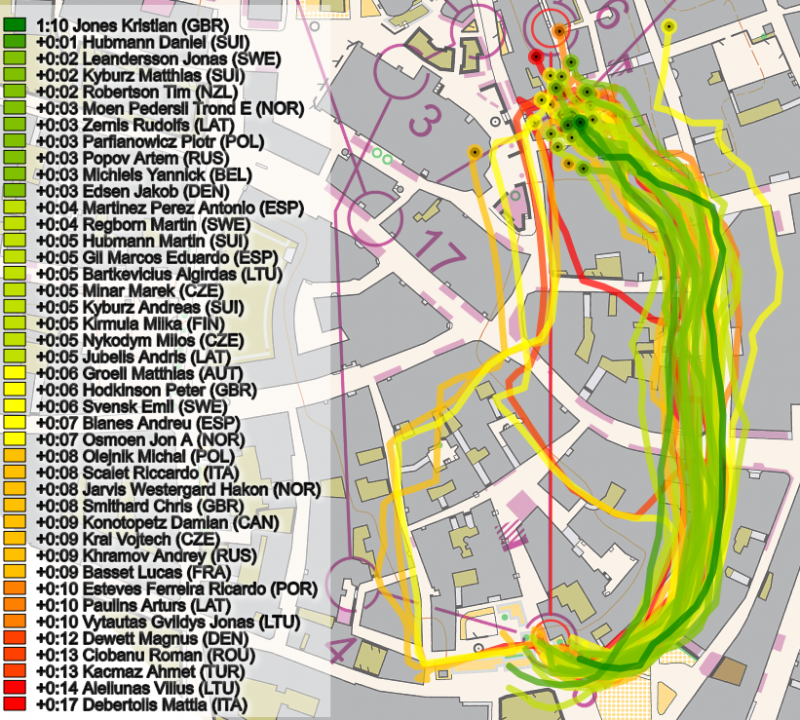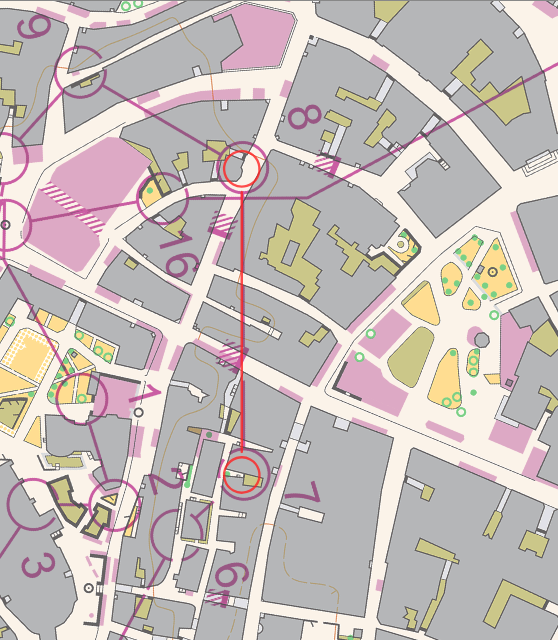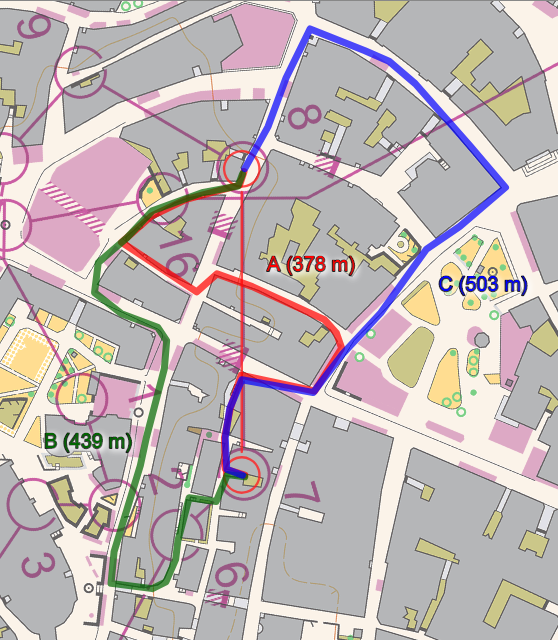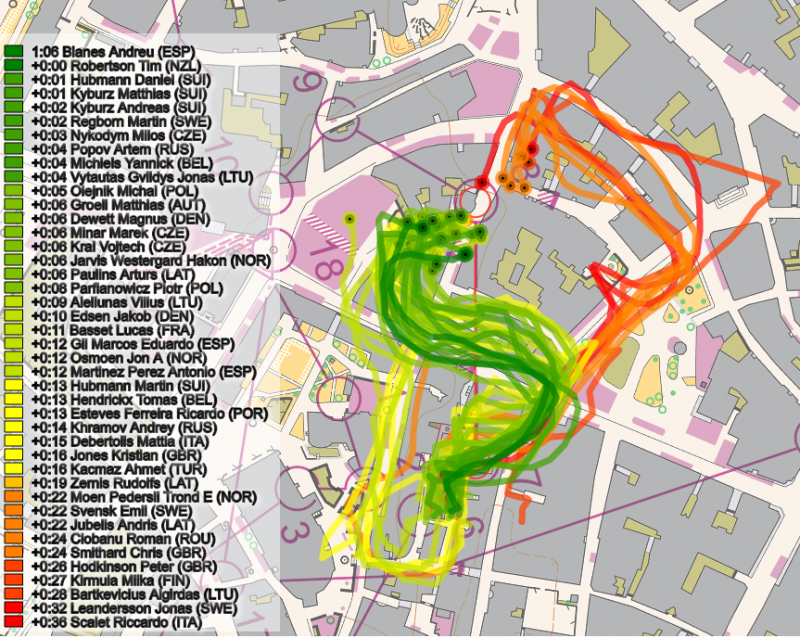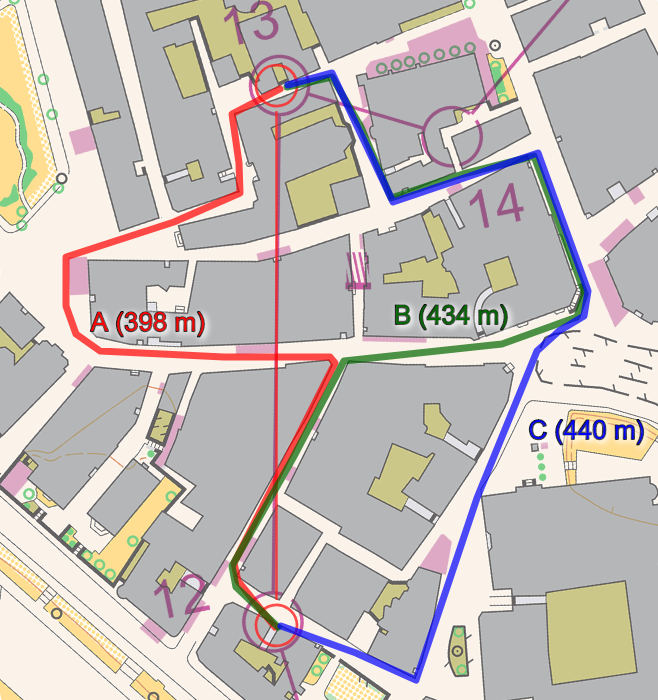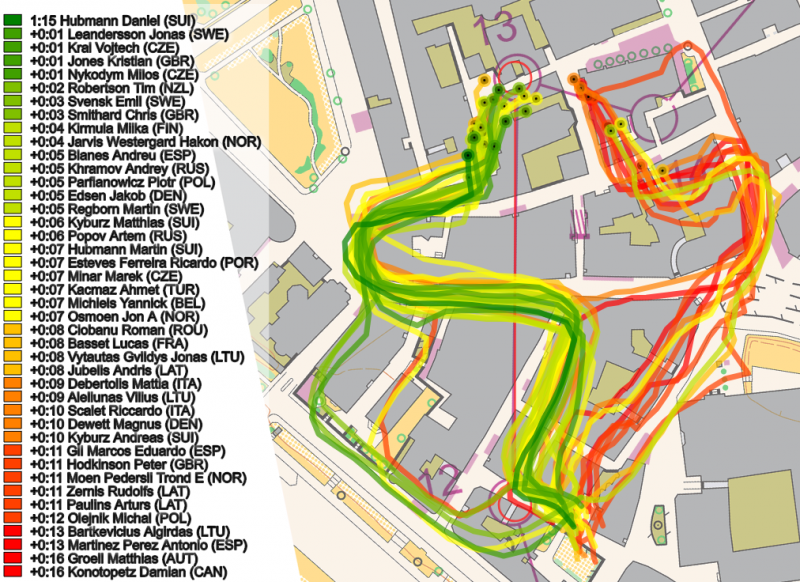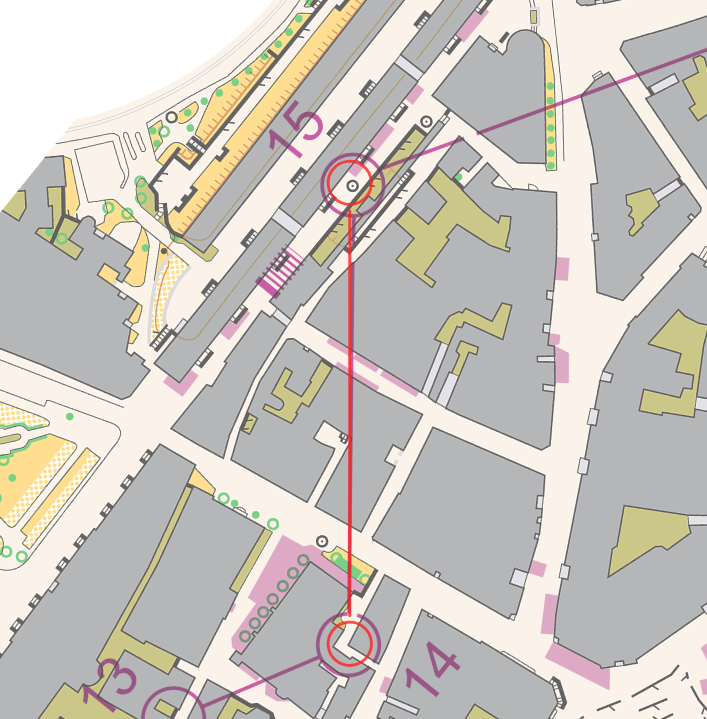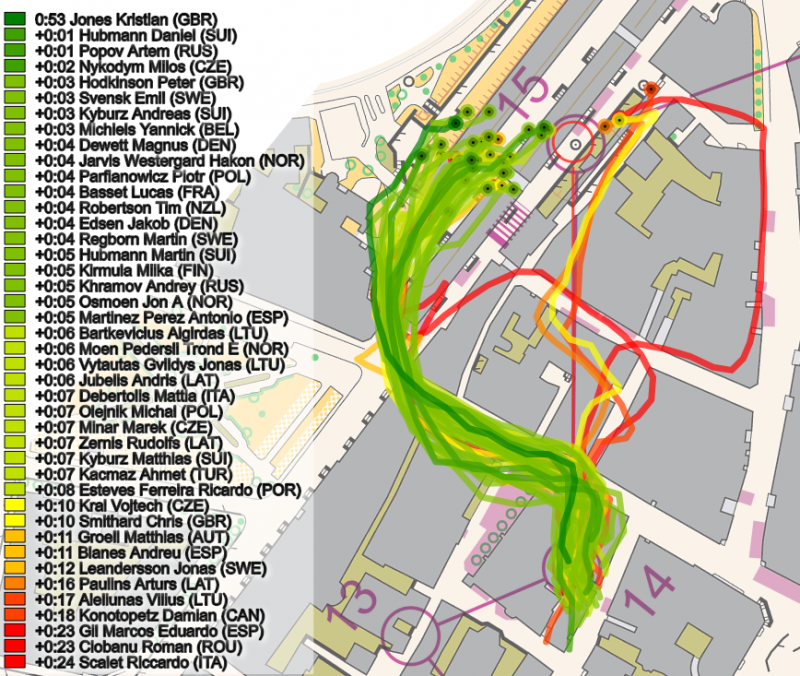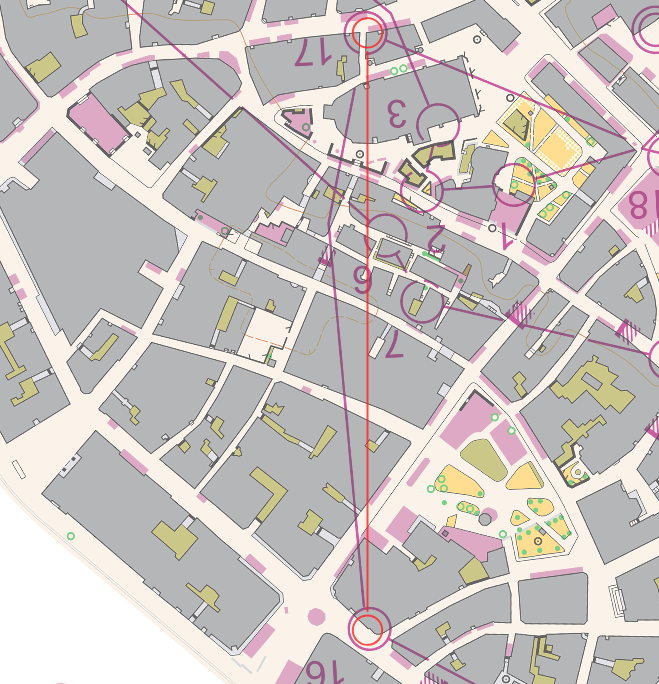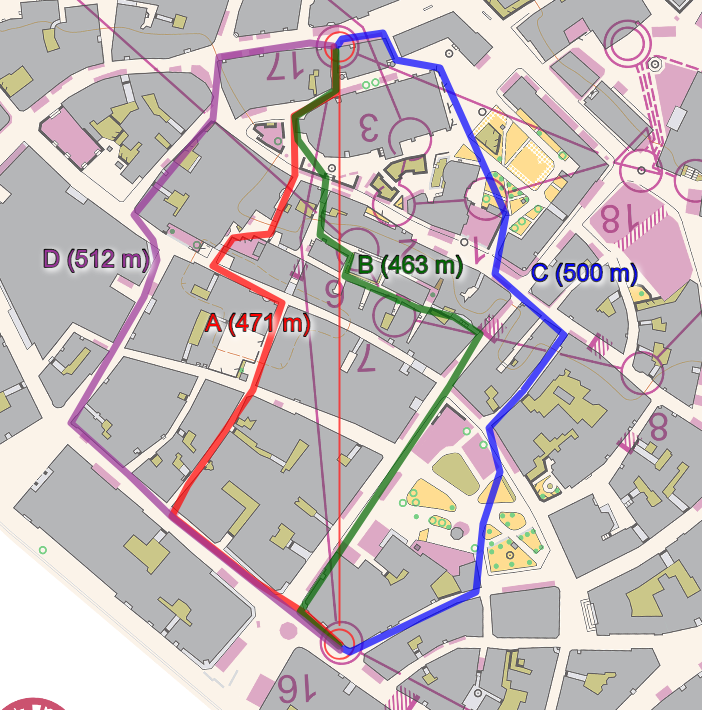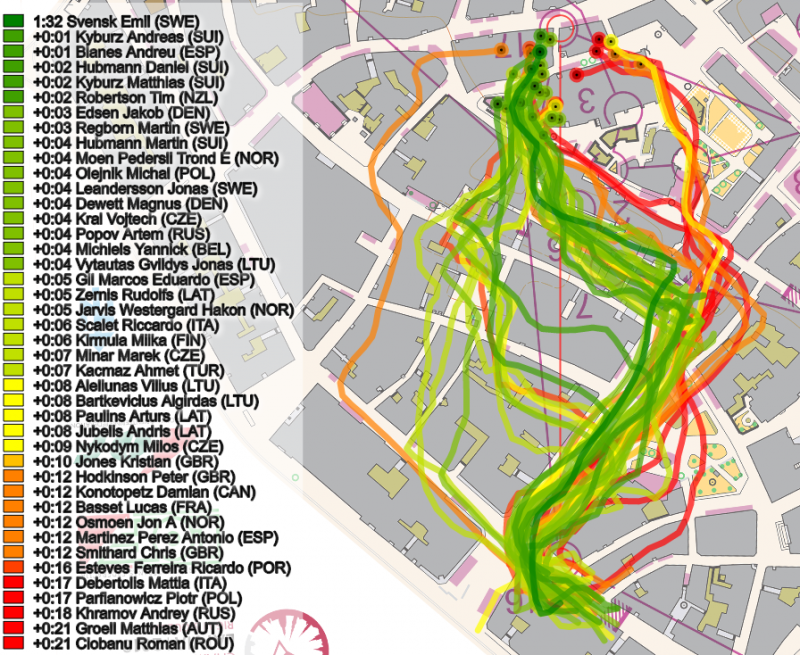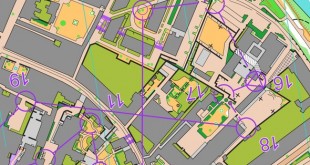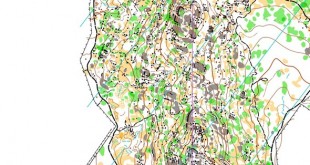The WOC 2018 Sprint courses offered several interesting routechoice legs – and many legs were also tricky from an execution point of view. Artificial barriers were used, otherwise the terrain would be too familiar for the runners who were working hard with previous orienteering maps and Google Maps to prepare themselves for the terrain, according to course setter Janis Tamusz.
The execution was also very tricky. The wet cobbles and crowds in the streets added a lot of extra stress for the runners.
The following analysis goes through the decisive points in the course – showing where the victory or medal chance was lost for the runners who had the speed for a top result. For maps, GPS-tracking and results from the race, see this summary article.
How were the medals won?
Daniel Hubmann and Tim Robertson took the two top places by running nearly clean races, both of them losing a maximum of 4 seconds to the fastest split time on each leg, and at the same time being among the fastest in the field. In the end the finish speed decided the gold for Hubmann. Andreas Kyburz took one bad routechoice (control 13) which cost him 10 seconds to the best split time, and in addition had somewhat lower speed than the gold and silver medalists. With 19 seconds up to the silver medal, Kyburz reached his maximum with a bronze medal this Saturday. The below graphic shows a graphical representation of the race development among the top runners.
Where were the medals lost?
Behind Kyburz there were however several runners who had the speed for a medal – some even for a gold medal – but who lost it due to either wrong routechoices, bad execution of a combination of these. Kris Jones had the fastest speed in the startfield, but with three major timelosses of 16 seconds (8th control), 22 seconds (16th control) and 10 seconds (18 control) due to sub-optimal execution and a bad routechoice, it does not help to be within one second of the best split time on 14 of 19 legs. Then a medal turns into a bitter 10th place, 38 seconds behind the winner.
Then a medal turns into a bitter 10th place, 38 seconds behind the winner.
Belgian Yannick Michiels in 4th did not have the speed of Jones (or maybe he ran with lower risk), but he had the bronze medal in his pocket at the very last control, but lost the bronze medal due to a slower split time to the finish from the last control – in addition to a wrong routechoice to the 4th control. Two other runners with medal speed were the Swedes Emil Svensk (6th) and Jonas Leandersson (19th). Both ran in medal speed, and both lost significant time to the 8th control – Svensk lost 22 seconds (exactly the same he was behind the winner in the end) and Leandersson 32 seconds (as much as he was behind a medal in the end). Both took the wrong routechoice to control 8, Leandersson in addition ran into a wrong alley on this control – and lost another 10 seconds later in the course by running into another wrong alley. Svensk also took the wrong route to control 6, losing 6 seconds there.
Reigning European champion Matthias Kyburz (finished 5th at +22 seconds, 2 seconds from a bronze medal) also had the winning speed, but had several smaller timelosses, the largest being 7 seconds to the 15th control and 6 seconds to the first control due to a wrong routechoice already out from the start. Andreu Blanes (Spain, 2 seconds from a medal) had very high speed, but two wrong routechoices and one major hesitation (see the analysis below) cost him the medal. Martin Regborn (Sweden, 6 seconds from a medal) was also only a wrong routechoice to control 4 away from winning a medal. Several other runners also lost their medal chances due to wrong routechoices at controls 4, 6, 8, 13, 15 or 17 (see the analysis below for more details).
Leg 7-8 at #WOC2018 Sprint was a really nice one – looking at the GPS-tracks colored by time you see how several runners missed the S-shaped shortest route, going right (+15-20 sec) or left (+5-10 sec). Execution was also tricky #GPS pic.twitter.com/UAjP7lDH4p
— WorldofO.com (@worldofo) August 4, 2018
WOC Sprint Men 2018

» See map in omaps.worldofo.com
Leg 1: High pressure & routechoice from the start
The start of the race was meant to put some pressure on the runners with short legs and intense map reading in busy streets full with pedestrians and outdoor cafes. There is a route choice to first control, but both options are almost equal length wise. Still, going right is some seconds slower, and surprisingly many runners lost 4-6 seconds on this leg, typically going right and choosing a some meters longer route. Matthias Kyburz is one of these taking the wrong route, losing 6 seconds (more than his gap to his older brother’s bronze medal) here by going right.
Leg 4: First routechoice leg
The two next legs where typical map-reading legs, but then the runners met the first real routechoice leg to control 4. Here the fastest routechoice is to the left in an S-shape to the right – some 20 meters shorter than running right. The course setter uses a “trick of the eye” here to make the runners go right; it feels both shorter and more straight, but there is even more S-shape than going left first. Several runners lose 4-10 seconds here by taking right. Most notably is Yannick Michiels who runs his worst leg here, losing 9 seconds with a wrong routechoice to the right.
The course setter uses a “trick of the eye” here to make the runners go right; it feels both shorter and more straight, but there is even more S-shape than going left first.
Andreu Blanes loses 6 seconds on the wrong routechoice – with only 2 seconds up to the medals this hurts more than for most, even if he is one of the fastest on the leg on this route (Blanes also loses significant time to control 15). Martin Regborn loses nearly 9 seconds – just his gap up to a bronze medal. Aleksi Niemi loses 17 seconds – nearly the gap up to the medals. Milos Nykodym‘s 13 second time loss is also a big chunk of the gap up to the medals, only 6 more to go (which he lost at control 17). Similar for Artem Popov – 12 seconds lost on this leg of the 17 seconds up to the medals. Håkon Jarvis Westergård also lost half of the 18 seconds timegap up to the medals on this routechoice. Andrey Khramov runs even more to the left, losing 37 seconds (not shown below), but he had several other significant timelosses.
The course setters comment for this leg and the next long leg to control 6:
– There are right and wrong options for these two legs and we expect majority of runners to choose the right ones, however, in this city terrain execution is as important as the route choice itself. Small alleyways, chaotic streets full with tourists and spectators as well as added pressure of a World Championship race will not make the task any easier.
Leg 6: First routechoice leg with artificial fences
The leg to control 6 is the first routechoice leg with articificial fences in play. Not a very tricky routechoice leg, it is quite easy to see that right is fastest (left is around 30 meters longer). The execution of this leg is however not easy, and many struggled in the area close to the control where you had to lower the speed and be accurate in reading the map. Of the top runners Emil Svensk took the wrong route to the left, but executed it very well and limited the time loss to 6 seconds. You could easily lose more on the best route to the right with sub-optimal execution.
You could easily lose more on the best route to the right with sub-optimal execution.
Leg 8: The “Queen leg” of the course
The leg to control 8 can be described as one of the highlights of the course. An intricate routechoice leg where it was difficult to see the best route going in S-shape quite straight. The three main options are shown below:
This is what the course setter says about the leg:
Here another route-choice leg follows, where artificial barriers are used extensively. The best option is the red route which is significantly faster than any other, however, again execution is the most important part – to spot the barriers on the map and to see the small canopy leading out of the control – in reality it looks just like a stairway hall of a living house. Another mind trick for the runners is to accept “S” type route choice as the best one.
And here is an overview of the routechoices the runners chose. Half of the field chose the wrong route, several struggling with the execution both straight and on the option to the right. This was definitely the most decisive leg in the race, with the following top runners losing significant time:
- Kris Jones takes the correct option, but struggled with the execution. Instead of the way out, he finds his way into a kitchen – not where you want to be in the middle of a WOC sprint race. 16 seconds lost for Jones, that’s the gap up to a medal. Jones own words: – To 8 the best route went through an opening that they had opened for the race – basically indoors through some corridor. I ran in and got to a fork with no indication of which way to go and took the right hand fork down some steps into a restaurant kitchen. I lost ~17 seconds to the fastest time on this leg and a big chunk will have been this. I wasn’t the only one who did this and it 100% needed to be taped or marshalled. See some discussion between the course setter and Kris Jones about this matter here.
- Emil Svensk runs to the right and loses 22 seconds and a medal.
- Jonas Leandersson runs to the right, and additionally hasn’s seen the artificial fence and runs into the alley and out again – loses 32 seconds and also a potential medal.
- Several other runners lose more than 20 seconds here – notably Trond Einar Moen Pedersli who was in 5th position before this mistake loses 22 seconds and Peter Hodkinson loses 26 seconds.
- Antonio Martinez Perez loses 12 seconds by running left
I ran in and got to a fork with no indication of which way to go and took the right hand fork down some steps into a restaurant kitchen.
Routechoice leg to 13: Tricky to see the shortest route
Now a few transport legs followed before the next routechoice leg to control 13. Here left is 40 meters and 8-10 seconds faster than right, but it is a bit difficult to see due to the artificial barrier.
It is easy to see when looking at the routes with split times though, note how all running right lose significant time. Of the top runners notably:
- Bronze medalist Andreas Kyburz loses 10 seconds – his biggest timeloss in the course
- Andreu Blanes is the fastest of the runners taking the wrong routechoice – losing only 5 seconds. Still, with 2 seconds up to the medals taking another wrong routechoice is not a nice feeling.
- Peter Hodkinson loses 11 seconds, Antonio Martinez Perez loses 13 seconds – along with the time loss to control 8 and another 10-12 seconds to control 17 this is the gap up to the medals for both of them.
- Trond Einar Moen Pedersli loses 11 seconds – along with the time loss to control 8 this is nearly the gap up to the medals.
Another nice & interesting leg in #WOC2018 Sprint – leg 12-13. Looking at GPS-tracks colored by time you see how left is 8-10 sec faster, but a bit difficult to see in speed due to the barrier. Three medalists take the wrong choice among others; Alm, Alexandersson and A Kyburz pic.twitter.com/jSxSVH1fRk
— WorldofO.com (@worldofo) August 4, 2018
Routechoice leg to 15: Big consequences, few took wrong
The leg to control 15 is again a routechoice leg where artificial boundaries play a central role. If you don’t see the best option (left) here, you can lose significant time. However, only very few runners made this mistake. Notably, however, Jonas Leandersson was one of them, starting into the alley with the artificial boundary and losing valuable time (12 seconds). Andreu Blanes also lost 11 seconds here due to getting uncertain and stopping on the correct routechoice – the third leg with significant timeloss due to mistake or wrong routechoice by Blanes.
Leg 16: Jones’ medal chance gone
The leg to control 16 is not really a tricky routehoice leg – most runners take the right choice, but Kris Jones manages to lose 22 seconds and his medal chance here by not seeing the artificial boundary (he was in 3rd position at control 15). In his own words: – I ran the next section well but ultimately pushed too hard and didn’t see the blocked alleyway to 16, running down the dead end. I lost 22s to the fastest time on this leg and that was the medal chances gone.
The course setter had the following comment about this leg:
– The third last and especially second last controls of the men’s’ course will offer, hopefully, decisive route choices in the fight for medals.
Leg 17: Last routechoice leg
The last routechoice leg was the leg to control 17 – with several options:
The fastest options here are the two middle options – either going through the narrow passage from leg 7-8 again (the other way) or slightly longer more to the left. Going right or left is 30-40 meters longer, and loses you 10 seconds or more. Several runners lost time here towards the end of the course.
- Notably Kris Jones has another 10 second time loss here – again on execution, and again in the narrow alley from leg 7-8. In his own words: – I went back through the corridor by 7 on the way to 17 and this time I was certain I knew the way. Except I didn’t, ran up the stairs to some landing and then back down, losing more time (+10s to the fastest on this leg). I’m not ashamed to say that my language at this point was far from PG.
- Other runners losing significant time towards a possible medal here were Peter Hodkinson (12 seconds, execution on the straight route), Milos Nykodym (9 seconds, variant of longer route to the right), Antonio Martinez Perez (12 seconds, longer route to the right).
A bit thanks to the sprint course-setter Janus Tamuzs for sharing some thoughts about the course for the purpose of this analysis article.
 World of O News
World of O News

